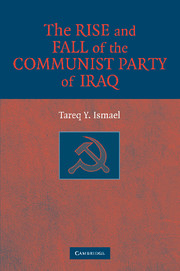Book contents
- Frontmatter
- Contents
- Preface
- 1 The Communist Party of Iraq: Origins and Foundations
- 2 Ascent of the ICP in Iraqi Politics
- 3 Party Rift: The Emergence of the Central Leadership
- 4 Alliance with the Baʿth
- 5 The Rebirth of the Central Leadership in the 1970s
- 6 Crisis: Disintegration or Renewal?
- 7 Conclusion: From Vanguard Activism to Rearguard Opportunism
- Index
5 - The Rebirth of the Central Leadership in the 1970s
Published online by Cambridge University Press: 24 November 2009
- Frontmatter
- Contents
- Preface
- 1 The Communist Party of Iraq: Origins and Foundations
- 2 Ascent of the ICP in Iraqi Politics
- 3 Party Rift: The Emergence of the Central Leadership
- 4 Alliance with the Baʿth
- 5 The Rebirth of the Central Leadership in the 1970s
- 6 Crisis: Disintegration or Renewal?
- 7 Conclusion: From Vanguard Activism to Rearguard Opportunism
- Index
Summary
In 1969 the ICP-CL faced an organizational deadlock as a result of the brutal treatment it had experienced at the hands of the Ba'thist regime. The ICP's split into factions left the CL temporarily rudderless, with the defection of the secretary-general and the submission of the rest of the leadership to the Baʿthists in the National Front. This was further compounded by the ICP-CL's refusal to be reconciled with the ICP-CC. There seemed to be no option left for its cadre except to face annihilation at the hands of the Baʿth security and police apparatus (as had already happened to their leadership) or to abandon political activism altogether. However, a new generation of committed cadre emerged, who concentrated their efforts on rejecting all cooperation, let alone the formation of an official alliance, with the Baʿth, and who aimed for a very tightly knit, secretive organizational structure and more defined ideology. Of course, such an organization took time to develop and when Party activists met for a plenary session in Qaradagh, a mountainous area in the vicinity of Sulaimaniyah in Iraqi Kurdistan, the regime had detailed knowledge of both the timing and place of the meeting. It dispatched three. MIG fighters and a Badger bomber to fly low-level runs over the location from 2:00 PM to 8:00 PM to signal the regime's ability to destroy the CL if it so desired.
The meeting was held in the area's main mosque. The planes attacked but the local population was sympathetic and warned the delegates by shouting. […]
- Type
- Chapter
- Information
- The Rise and Fall of the Communist Party of Iraq , pp. 204 - 263Publisher: Cambridge University PressPrint publication year: 2007

